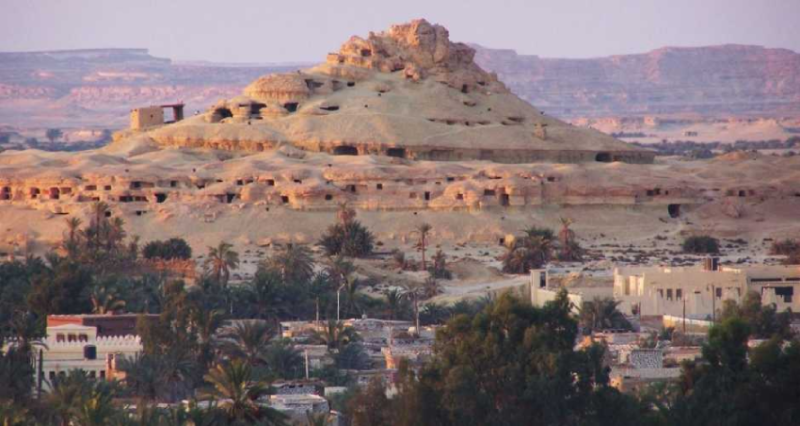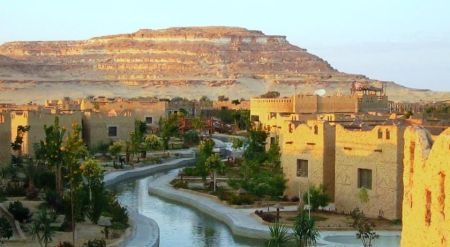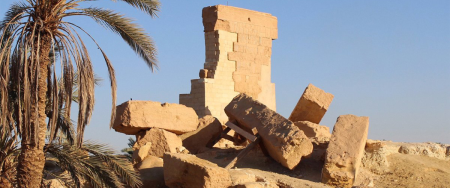the mountain of the dead

The Mountain of the Dead: The Ancient Necropolis of Siwa Oasis
Hidden within the golden sands of the Egyptian Western Desert lies a mysterious landmark that echoes with the whispers of eternity — the Mountain of the Dead. Known locally as Gebel al-Mawta, this towering limestone hill near the heart of Siwa Oasis stands as a timeless symbol of Egypt’s ancient funerary traditions. Its honeycombed slopes, carved with hundreds of rock-cut tombs, tell silent yet powerful stories of life, death, and rebirth from centuries past. Travelers who climb its sun-scorched paths are rewarded with more than just breathtaking views — they discover a sacred necropolis where the living once communed with the dead, and where the desert itself guards the secrets of lost civilizations.
The Mountain of the Dead isn’t merely a burial ground; it’s an archaeological treasure trove revealing layers of cultural fusion between ancient Egyptian, Greek, and Roman influences. Inside these tombs, vibrant wall paintings and hieroglyphic inscriptions still cling to the stone, defying time and sand. The site’s haunting serenity evokes a deep sense of wonder and respect, making it an essential stop for anyone embarking on Egypt Travel Packages or pursuing the ultimate desert adventure through Egypt Desert Tours. Whether you’re a history enthusiast, a cultural explorer, or a seeker of hidden gems, the Mountain of the Dead offers a glimpse into Egypt’s enigmatic soul — untouched, raw, and eternal.
Unveiling the Origins of the Mountain of the Dead
The Mountain of the Dead dates back to the 26th Dynasty (around the 6th century BCE) and flourished through the Greek and Roman periods. Its unique architecture tells a tale of evolving beliefs about the afterlife. The necropolis served as the final resting place for locals and nobles alike, symbolizing the deep spiritual connection between the Siwans and their ancestors. During World War II, locals even sought refuge inside these ancient tombs, adding yet another layer to its multifaceted history.
Early explorers were mesmerized by the site’s labyrinth of burial chambers, each whispering the names of forgotten souls. Archaeologists uncovered mummies wrapped in linen, amulets depicting deities, and pottery offerings—all testaments to Siwa’s vibrant past. The necropolis’s vantage point overlooking the oasis was no coincidence; ancient Egyptians believed such elevation brought the deceased closer to the heavens. This sacred mountain remains one of Siwa’s most revered landmarks, drawing visitors from across the globe through curated Egypt Excursions.
Architectural Marvels Hidden in the Desert Rock
The tombs carved into Gebel al-Mawta are small yet intricately detailed. Craftsmen of ancient times transformed the limestone into eternal homes for the departed. Four of the most famous tombs — Si-Amun, Mesu-Isis, Niperpathot, and the Crocodile Tomb — each showcase distinct styles. The Tomb of Si-Amun, for instance, reveals vivid paintings of divine figures, while the Tomb of Mesu-Isis boasts finely inscribed hieroglyphs praising Osiris, the god of the afterlife.
These tombs blend Egyptian iconography with Hellenistic artistry, a result of cultural exchange during the Ptolemaic era. The depictions of winged deities, lotus motifs, and celestial boats reveal a belief system where death was merely a journey to another life. Such artistic harmony makes the Mountain of the Dead a living museum, offering clues to Egypt’s cosmopolitan past and deep spiritual traditions.
Spiritual Symbolism and the Afterlife Journey
The ancient Siwans believed that the soul’s journey continued after death, and the mountain’s very name reflected their reverence for this passage. The deceased were laid to rest with personal belongings, jewelry, and sacred symbols ensuring safe transit to the realm of Osiris. The necropolis’s proximity to the Oracle of Amun further enhanced its spiritual significance. Pilgrims sought the oracle’s guidance before burial rituals, blending mysticism with ritual precision.
Even today, locals hold the mountain in high regard, preserving its aura of sanctity. The dry desert air has remarkably preserved many tombs, allowing modern archaeologists to study mummification techniques similar to those found in Thebes or the Valley of the Kings. Such discoveries shed light on how far-reaching ancient Egyptian burial practices truly were.
The Mountain’s Role in Siwa’s Cultural Identity
Beyond its archaeological importance, the Mountain of the Dead is a cornerstone of Siwan identity. Its scenery merges perfectly with the surrounding palm groves, salt lakes, and the shimmering dunes of the Great Sand Sea. Locals share oral legends of spirits guarding the tombs, blending myth with memory. Each story passed down through generations reaffirms the mountain’s place in Siwa’s heritage, making it not just a remnant of the past but a living symbol of continuity.
Modern explorers visiting Siwa will find this site easily accessible from town, especially when paired with visits to nearby attractions like the Cleopatra Spring, Dakrour Mountain, and Shali Castle. Together, they paint a vivid picture of Siwa’s timeless charm—a blend of spirituality, nature, and adventure.
Scientific Discoveries and Archaeological Insights
Excavations at the Mountain of the Dead have revealed extraordinary finds, including painted coffins, funerary masks, and Greco-Roman-style mummies. Researchers studying pigments used in tomb paintings have identified natural minerals mixed with plant-based binders, proving that ancient artisans adapted local resources with remarkable ingenuity. These findings continue to reshape our understanding of funerary art outside the Nile Valley.
Radiocarbon analysis of organic materials has also provided accurate dating, aligning Siwa’s necropolis with Egypt’s Late Period. Moreover, the inscriptions uncovered here often mention priests and dignitaries linked to the Amun cult, strengthening the connection between Siwa and the major religious centers along The Nile River. Such links emphasize that even in its isolation, Siwa was deeply integrated into Egypt’s spiritual and political networks.
Visiting the Mountain of the Dead Today
Today, the Mountain of the Dead stands as one of Egypt’s most evocative destinations for travelers seeking authenticity and mystery. The best way to explore the site is during the early morning or late afternoon when the desert’s golden light enhances the atmosphere. Many visitors combine a trip to the necropolis with guided Egypt Vacations Packages that include Siwa’s natural wonders and cultural landmarks.
Climbing the mountain allows panoramic views over the oasis, with palm-fringed lakes shimmering under the blazing sun. Each cave and tomb holds a story etched into stone — a quiet echo of prayers, offerings, and the eternal human desire to transcend mortality. Visitors are encouraged to tread respectfully and avoid entering sealed tombs, preserving the fragile wall art for future generations.
When to Go and What to Expect
The best time to visit the Mountain of the Dead is between October and April when the desert heat is mild and the skies remain crystal clear. Travelers often pair their visit with other Western Desert adventures, including trips to the White Desert of Egypt or the nearby Bahariya Oasis Egypt. Whether arriving by 4x4 safari or local transport, the experience of standing atop Gebel al-Mawta is nothing short of spellbinding.
Preservation Efforts and Future Prospects
As tourism grows in Siwa, preserving the Mountain of the Dead becomes increasingly vital. Conservationists and local authorities are implementing measures to stabilize tomb structures and protect wall art from erosion. Restoration teams document hieroglyphs and paintings using digital imaging, ensuring that even as the desert shifts, the stories of the dead endure forever.
Efforts to promote sustainable tourism also prioritize community involvement, enabling Siwans to benefit economically while safeguarding their heritage. With support from Egypt’s Ministry of Antiquities and international collaborations, the necropolis is poised to become a cornerstone of cultural tourism in the region, enriching the global narrative of ancient Egypt.
Frequently Asked Questions About the Mountain of the Dead
What is the Mountain of the Dead in Siwa Oasis?
The Mountain of the Dead, or Gebel al-Mawta, is an ancient necropolis near Siwa Oasis in Egypt’s Western Desert. It contains hundreds of rock-cut tombs dating back to the 26th Dynasty and the Greco-Roman period. Its tombs feature vibrant wall paintings and inscriptions reflecting the spiritual beliefs of ancient Siwans.
Where is the Mountain of the Dead located?
The Mountain of the Dead stands about one kilometer north of Siwa town center, within easy reach of major attractions such as the Oracle of Amun and Shali Fortress. It rises prominently above the oasis, offering panoramic views of the surrounding desert landscape.
What can visitors expect to see at the Mountain of the Dead?
Visitors can explore rock-carved tombs, some adorned with colorful murals and hieroglyphs. The site also offers sweeping views of Siwa Oasis, palm groves, and salt lakes. Tombs such as Si-Amun’s and Mesu-Isis’s are open to visitors, revealing intricate artwork from Egypt’s late dynastic period.
Why is it called the Mountain of the Dead?
The name ‘Mountain of the Dead’ stems from its ancient role as a necropolis where the deceased were buried in rock-hewn chambers. For locals, the mountain symbolized a sacred link between the earthly world and the afterlife, a place where spirits ascended toward the divine.
When is the best time to visit the Mountain of the Dead?
The ideal time to visit is between October and April when temperatures are pleasant for exploring. Early morning and sunset hours provide the best lighting for photography and a serene atmosphere to appreciate the site’s mystical beauty.







